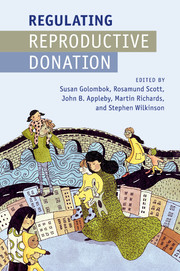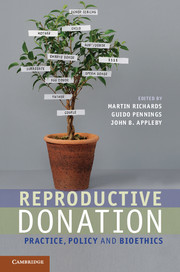26 results
Index
-
- Book:
- Regulating Reproductive Donation
- Published online:
- 05 March 2016
- Print publication:
- 01 April 2016, pp 373-382
-
- Chapter
- Export citation
Part I - International, cross-border and global issues
-
- Book:
- Regulating Reproductive Donation
- Published online:
- 05 March 2016
- Print publication:
- 01 April 2016, pp 37-162
-
- Chapter
- Export citation
Contents
-
- Book:
- Regulating Reproductive Donation
- Published online:
- 05 March 2016
- Print publication:
- 01 April 2016, pp v-vii
-
- Chapter
- Export citation
Part IV - Information about donors
-
- Book:
- Regulating Reproductive Donation
- Published online:
- 05 March 2016
- Print publication:
- 01 April 2016, pp 291-372
-
- Chapter
- Export citation
15 - Regulating the provision of donor information to donor-conceived children
- from Part IV - Information about donors
-
-
- Book:
- Regulating Reproductive Donation
- Published online:
- 05 March 2016
- Print publication:
- 01 April 2016, pp 334-351
-
- Chapter
- Export citation
Editors, contributors and discussants
-
- Book:
- Regulating Reproductive Donation
- Published online:
- 05 March 2016
- Print publication:
- 01 April 2016, pp viii-ix
-
- Chapter
- Export citation
Copyright page
-
- Book:
- Regulating Reproductive Donation
- Published online:
- 05 March 2016
- Print publication:
- 01 April 2016, pp iv-iv
-
- Chapter
- Export citation
Acknowledgements
-
- Book:
- Regulating Reproductive Donation
- Published online:
- 05 March 2016
- Print publication:
- 01 April 2016, pp x-xii
-
- Chapter
- Export citation
Part III - Donors
-
- Book:
- Regulating Reproductive Donation
- Published online:
- 05 March 2016
- Print publication:
- 01 April 2016, pp 205-290
-
- Chapter
- Export citation
Part II - How many children per donor?
-
- Book:
- Regulating Reproductive Donation
- Published online:
- 05 March 2016
- Print publication:
- 01 April 2016, pp 163-204
-
- Chapter
- Export citation
Introduction
-
-
- Book:
- Regulating Reproductive Donation
- Published online:
- 05 March 2016
- Print publication:
- 01 April 2016, pp 1-13
-
- Chapter
- Export citation

Regulating Reproductive Donation
-
- Published online:
- 05 March 2016
- Print publication:
- 01 April 2016
Contributors
-
-
- Book:
- Relatedness in Assisted Reproduction
- Published online:
- 05 August 2014
- Print publication:
- 14 August 2014, pp vii-ix
-
- Chapter
- Export citation
4 - On the moral importance of genetic ties in families
- from Part I - Conceptualising relatedness
-
-
- Book:
- Relatedness in Assisted Reproduction
- Published online:
- 05 August 2014
- Print publication:
- 14 August 2014, pp 79-96
-
- Chapter
- Export citation
Acknowledgements
-
- Book:
- Reproductive Donation
- Published online:
- 05 August 2012
- Print publication:
- 05 July 2012, pp ix-x
-
- Chapter
- Export citation
1 - Introduction
-
-
- Book:
- Reproductive Donation
- Published online:
- 05 August 2012
- Print publication:
- 05 July 2012, pp 1-12
-
- Chapter
- Export citation
13 - Is disclosure in the best interests of children conceived by donation?
-
-
- Book:
- Reproductive Donation
- Published online:
- 05 August 2012
- Print publication:
- 05 July 2012, pp 231-249
-
- Chapter
- Export citation

Reproductive Donation
- Practice, Policy and Bioethics
-
- Published online:
- 05 August 2012
- Print publication:
- 05 July 2012
12 - Reproductive donation and justice for gay and lesbian couples
-
-
- Book:
- Reproductive Donation
- Published online:
- 05 August 2012
- Print publication:
- 05 July 2012, pp 211-230
-
- Chapter
- Export citation
Contributors
-
- Book:
- Reproductive Donation
- Published online:
- 05 August 2012
- Print publication:
- 05 July 2012, pp vii-viii
-
- Chapter
- Export citation



